Over the past number of years, the move towards the electrification of vehicles has grown exponentially.
There is no doubting that the future for battery-electric is bright, particularly in the lower performance vehicle range and for applications such as for materials handling, municipal and horticulture.
Many will agree that ATVs and UTVs also fall into this category.
The majority of ATV users typically only use the machine for short periods and for relatively light work, such as herding livestock or fencing etc. For these types of users, we can see huge potential for battery-electric ATVs. For the people spending long days spreading fertiliser or similar tasks, the move to full electrification, solely based on range capacity, may be some time away.
We recently got the opportunity to spend some time with the Powerland Tachyon. The electric ATV was only launched in August 2023, and landed in Ireland in October.
The company has 200 units built to date, with plans to turn out another 1,000 units by the end of this year.

The handlebars are nicely positioned and the control layout is what you would expect from a typical popular ATV on the market.
Who are Powerland?
Powerland ATV is a new name on the Irish ATV market. Manufactured in Goa in India, the firm previously built petrol-powered ATVs and now have made a full move to battery-electric.
The firm currently only offers the one model, namely the Tachyon.
However, it is currently developing a 400cc equivalent electric ATV and a 1,000cc equivalent electric UTV. The company exports to 13 countries.
It has 50 employees, and based on the current demand and future outlook, it has plans to take on another 90 staff in the next year.

It features independent double wishbone suspension.
The brand first entered Ireland late last year, and is being imported and distributed in Ireland by Noel Turley Auto Sales. The Galway-based distributor has said it has appointed three dealers and is in the process of appointing more dealers across the country.
It has sold 10 Tachyons in Ireland to-date. 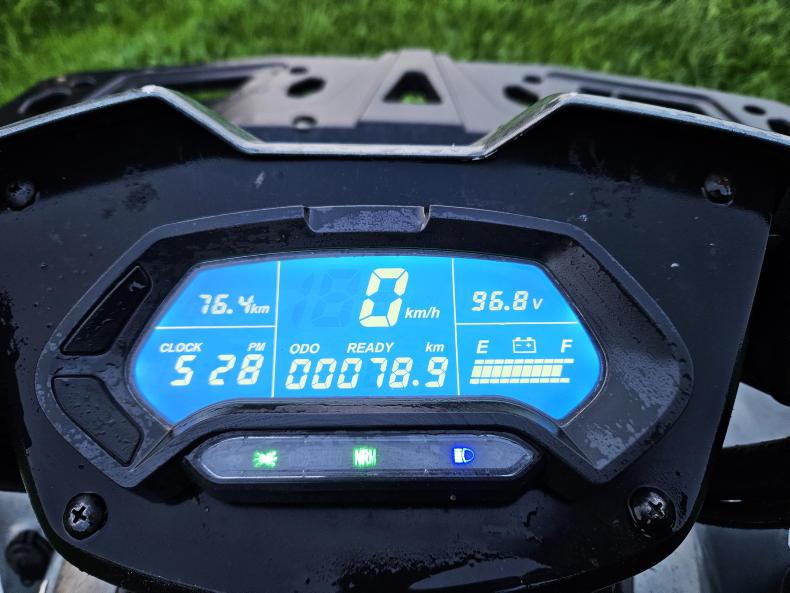
Centred between the handle bars is a large digital-dash display.
Driveline
The Tachyon sources its power from an 11.2kWh lithium-ion battery, which the manufacturer says is the equivalent output to 48hp.
When it comes to quads, we all talk in cc, and the Tachyon directly converts to 720cc. So this bike is no small unit, it’s a sizeable piece of kit.
Power from the battery is transferred directly to the wheel motors. Anyone who has any experience driving an electric vehicle will always comment about the surge of instant power, and this is why.
There is no loss of power through shafts or a transmission. This design means there are fewer mechanical components and less heat generated.
With no transmission as such, it means there are no ranges, it’s as simple as drive (forward), neutral and reverse.
These are selected by navigating a centrally positioned switch gear, which can only be changed when the bike is stopped, with the brake pressed. The bike also features selectable 4WD as expected.

We charged the battery sporadically, between jobs whenever it was free, but six hours from flat when plugged into a regular 240V socket for a full charge sounded correct.
The manufacturer says it has a range of up to 110km in eco mode, and that it takes six hours to fully charge. It features two modes, eco and boost.
It says peak torque is 210Nm, 0-60km/h is achieved in under four seconds, while top speed is 85km/h.
From our experience, the quad was well capable of hitting 0-60km/h in this timeframe, and was capable of a top speed in excess of 100km/h.
Charging
We charged the battery sporadically, whenever it was free between jobs, but six hours from flat when plugged into a regular 240V socket for a full charge sounded correct.
In terms of the range, if you were driving it easy at light work, you probably would squeeze 100-110km out of a full battery.
However, doing heavier work, in four-wheel drive-in boost mode will naturally be heavier on juice, and would pose a realistic range of 60km. If towing 500kg at a speed of 10-12km/h, you would get three to fours hours out of a full charge.
The bike features a regenerative braking system, which allows it to re-use the energy typically lost during braking to re-charge the battery.
Powerland says that during field applications, it would charge the battery by 5%, while on the road this would increase to 8%. This feature also acts as an engine braking system, giving the operator better control in certain situations such as going downhill.
With no transmission as such, it means there are no ranges, it’s as simple as drive (forward), neutral and reverse.
Build
The structure of the bike is rugged. The outer plastic panels appear a bit on the lighter side, but outside of that the build quality appears to be very good.
Its specification in terms of carrying capacity, towing capacity and weight is all in line with popular petrol-powered bikes in the 700c category.
The bike comes with just the one specification as standard. Weighing in at 375kg, it has a hitch towing capacity rating of 500kg. The front and rear racks offer 60kg and 75kg carrying capacities, respectively.
The chassis, battery pack, panels and the wiring harness are made in-house, and to be fair, couldn’t be faulted. As expected, the bike features four-wheel ventilated disc brakes.

Weighing in at 375kg, it has a hitch towing capacity rating of 500kg.
Controls
The handle bars are nicely positioned and the control layout is what you would expect from a typical popular ATV on the market. Lights, indicators, engine kill switch and the horn are positioned on the left-hand cluster.
Meanwhile, the 2wd/4wd switch, the eco/boost mode switch and the accelerator are on the right-hand side.
Centred between the handle bars is a large digital-dash display. It relays the speedometer, battery power level, battery voltage, the time and the odometer.
The status of 4wd or the driving mode isn’t displayed on the screen. The ignition switch is positioned beside a 12v power supply on the right-hand front fender.
On the keyring are battery operated controls for the 750kg capacity winch, which comes as a standard feature. The model is fitted with 12in alloys and 25x10, six ply tyres.

A 750kg capacity winch comes as a standard feature.
There are two storage compartments on board, the first is water-resistant and is positioned directly underneath the operator’s seat. The second compartment is underneath the rear taillight.
As standard, the bike is fitted with automotive style LED headlights and taillights. The carbon grey is a nice colour, and it’s also available in neon green, matte black and artic white.
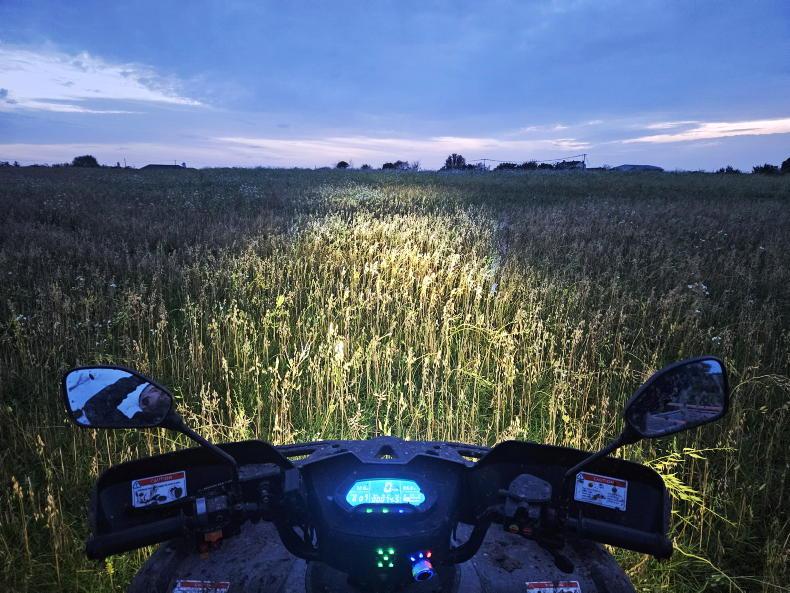
The LED front and rear lighting is crisp, and provides super illumination in the dark.
Verdict
The bike is well presented, with a modern look and a sporty trim. The LED front and rear lighting is crisp, and provides super illumination in the dark.
As we are becoming accustomed to with electrification, the get up and go of the bike is serious. It would leave a petrol equivalent for dead on take-off. Ride comfort is also top class.
The only thing that I would like the manufacturer to improve on is the range of the battery. When you work the quad hard, with boost mode and four-wheel drive engaged, it really saps the battery.
Even under this load, the battery is still fit to do north of 55km to a charge. However, we are a power-hungry nation, so when it comes to range, we are always going to be greedy and look for more.
Powerland has said it will have a new 15.6kwh battery on the market shortly, which will be offering a larger capacity.
One major point to take into consideration is the running costs of this v a petrol-powered bike. The Irish distributor says a full charge costs €1.60 on electricity. Most 700cc bikes have an 18-litre fuel tank, which would cost around €30 to fill.
The other feature with electric drive is how quiet is it. We found this to be a great positive, when working around sheds with livestock. When we look at the electric ATV market, there is a very limited selection to choose from, and what’s there is priced well and above the Powerland Tachyon.
From our brief chance to get behind the handle bars, we were very impressed. Powerland is pioneering battery-electric drive in ATVs and the Tachyon is definitely on the right path. It will be a real market contender going forward.

As standard, the bike is fitted with automotive style LED headlights and taillights.
Likes
Instant power. Ride comfort.Very quiet.Low running costs.Dislikes
Needs extended wheel arches/fenders to be added at rear to stop spraying effect.Would like more battery range.Machine specModel: Powerland Tachyon. Battery: 11.2kWh lithium-ion battery (48hp equivalent).Charging time: 87.6 volts, 20 amp six-hour charge time. Transmission: direct drive to wheel motor, with selectable 4WD.Suspension: independent double wishbone. Rack capacity: 60kg front and 75kg rear.Rated towing capacity: 500kg.Dry weight: 375kg.Dimensions: 2350 x 1340 x 1420mm (LxWxH)Ground clearance: 300mm.Wheel base: 1,455mm. Price: €13,990 plus VAT.
Over the past number of years, the move towards the electrification of vehicles has grown exponentially.
There is no doubting that the future for battery-electric is bright, particularly in the lower performance vehicle range and for applications such as for materials handling, municipal and horticulture.
Many will agree that ATVs and UTVs also fall into this category.
The majority of ATV users typically only use the machine for short periods and for relatively light work, such as herding livestock or fencing etc. For these types of users, we can see huge potential for battery-electric ATVs. For the people spending long days spreading fertiliser or similar tasks, the move to full electrification, solely based on range capacity, may be some time away.
We recently got the opportunity to spend some time with the Powerland Tachyon. The electric ATV was only launched in August 2023, and landed in Ireland in October.
The company has 200 units built to date, with plans to turn out another 1,000 units by the end of this year.

The handlebars are nicely positioned and the control layout is what you would expect from a typical popular ATV on the market.
Who are Powerland?
Powerland ATV is a new name on the Irish ATV market. Manufactured in Goa in India, the firm previously built petrol-powered ATVs and now have made a full move to battery-electric.
The firm currently only offers the one model, namely the Tachyon.
However, it is currently developing a 400cc equivalent electric ATV and a 1,000cc equivalent electric UTV. The company exports to 13 countries.
It has 50 employees, and based on the current demand and future outlook, it has plans to take on another 90 staff in the next year.

It features independent double wishbone suspension.
The brand first entered Ireland late last year, and is being imported and distributed in Ireland by Noel Turley Auto Sales. The Galway-based distributor has said it has appointed three dealers and is in the process of appointing more dealers across the country.
It has sold 10 Tachyons in Ireland to-date. 
Centred between the handle bars is a large digital-dash display.
Driveline
The Tachyon sources its power from an 11.2kWh lithium-ion battery, which the manufacturer says is the equivalent output to 48hp.
When it comes to quads, we all talk in cc, and the Tachyon directly converts to 720cc. So this bike is no small unit, it’s a sizeable piece of kit.
Power from the battery is transferred directly to the wheel motors. Anyone who has any experience driving an electric vehicle will always comment about the surge of instant power, and this is why.
There is no loss of power through shafts or a transmission. This design means there are fewer mechanical components and less heat generated.
With no transmission as such, it means there are no ranges, it’s as simple as drive (forward), neutral and reverse.
These are selected by navigating a centrally positioned switch gear, which can only be changed when the bike is stopped, with the brake pressed. The bike also features selectable 4WD as expected.

We charged the battery sporadically, between jobs whenever it was free, but six hours from flat when plugged into a regular 240V socket for a full charge sounded correct.
The manufacturer says it has a range of up to 110km in eco mode, and that it takes six hours to fully charge. It features two modes, eco and boost.
It says peak torque is 210Nm, 0-60km/h is achieved in under four seconds, while top speed is 85km/h.
From our experience, the quad was well capable of hitting 0-60km/h in this timeframe, and was capable of a top speed in excess of 100km/h.
Charging
We charged the battery sporadically, whenever it was free between jobs, but six hours from flat when plugged into a regular 240V socket for a full charge sounded correct.
In terms of the range, if you were driving it easy at light work, you probably would squeeze 100-110km out of a full battery.
However, doing heavier work, in four-wheel drive-in boost mode will naturally be heavier on juice, and would pose a realistic range of 60km. If towing 500kg at a speed of 10-12km/h, you would get three to fours hours out of a full charge.
The bike features a regenerative braking system, which allows it to re-use the energy typically lost during braking to re-charge the battery.
Powerland says that during field applications, it would charge the battery by 5%, while on the road this would increase to 8%. This feature also acts as an engine braking system, giving the operator better control in certain situations such as going downhill.
With no transmission as such, it means there are no ranges, it’s as simple as drive (forward), neutral and reverse.
Build
The structure of the bike is rugged. The outer plastic panels appear a bit on the lighter side, but outside of that the build quality appears to be very good.
Its specification in terms of carrying capacity, towing capacity and weight is all in line with popular petrol-powered bikes in the 700c category.
The bike comes with just the one specification as standard. Weighing in at 375kg, it has a hitch towing capacity rating of 500kg. The front and rear racks offer 60kg and 75kg carrying capacities, respectively.
The chassis, battery pack, panels and the wiring harness are made in-house, and to be fair, couldn’t be faulted. As expected, the bike features four-wheel ventilated disc brakes.

Weighing in at 375kg, it has a hitch towing capacity rating of 500kg.
Controls
The handle bars are nicely positioned and the control layout is what you would expect from a typical popular ATV on the market. Lights, indicators, engine kill switch and the horn are positioned on the left-hand cluster.
Meanwhile, the 2wd/4wd switch, the eco/boost mode switch and the accelerator are on the right-hand side.
Centred between the handle bars is a large digital-dash display. It relays the speedometer, battery power level, battery voltage, the time and the odometer.
The status of 4wd or the driving mode isn’t displayed on the screen. The ignition switch is positioned beside a 12v power supply on the right-hand front fender.
On the keyring are battery operated controls for the 750kg capacity winch, which comes as a standard feature. The model is fitted with 12in alloys and 25x10, six ply tyres.

A 750kg capacity winch comes as a standard feature.
There are two storage compartments on board, the first is water-resistant and is positioned directly underneath the operator’s seat. The second compartment is underneath the rear taillight.
As standard, the bike is fitted with automotive style LED headlights and taillights. The carbon grey is a nice colour, and it’s also available in neon green, matte black and artic white.

The LED front and rear lighting is crisp, and provides super illumination in the dark.
Verdict
The bike is well presented, with a modern look and a sporty trim. The LED front and rear lighting is crisp, and provides super illumination in the dark.
As we are becoming accustomed to with electrification, the get up and go of the bike is serious. It would leave a petrol equivalent for dead on take-off. Ride comfort is also top class.
The only thing that I would like the manufacturer to improve on is the range of the battery. When you work the quad hard, with boost mode and four-wheel drive engaged, it really saps the battery.
Even under this load, the battery is still fit to do north of 55km to a charge. However, we are a power-hungry nation, so when it comes to range, we are always going to be greedy and look for more.
Powerland has said it will have a new 15.6kwh battery on the market shortly, which will be offering a larger capacity.
One major point to take into consideration is the running costs of this v a petrol-powered bike. The Irish distributor says a full charge costs €1.60 on electricity. Most 700cc bikes have an 18-litre fuel tank, which would cost around €30 to fill.
The other feature with electric drive is how quiet is it. We found this to be a great positive, when working around sheds with livestock. When we look at the electric ATV market, there is a very limited selection to choose from, and what’s there is priced well and above the Powerland Tachyon.
From our brief chance to get behind the handle bars, we were very impressed. Powerland is pioneering battery-electric drive in ATVs and the Tachyon is definitely on the right path. It will be a real market contender going forward.

As standard, the bike is fitted with automotive style LED headlights and taillights.
Likes
Instant power. Ride comfort.Very quiet.Low running costs.Dislikes
Needs extended wheel arches/fenders to be added at rear to stop spraying effect.Would like more battery range.Machine specModel: Powerland Tachyon. Battery: 11.2kWh lithium-ion battery (48hp equivalent).Charging time: 87.6 volts, 20 amp six-hour charge time. Transmission: direct drive to wheel motor, with selectable 4WD.Suspension: independent double wishbone. Rack capacity: 60kg front and 75kg rear.Rated towing capacity: 500kg.Dry weight: 375kg.Dimensions: 2350 x 1340 x 1420mm (LxWxH)Ground clearance: 300mm.Wheel base: 1,455mm. Price: €13,990 plus VAT. 













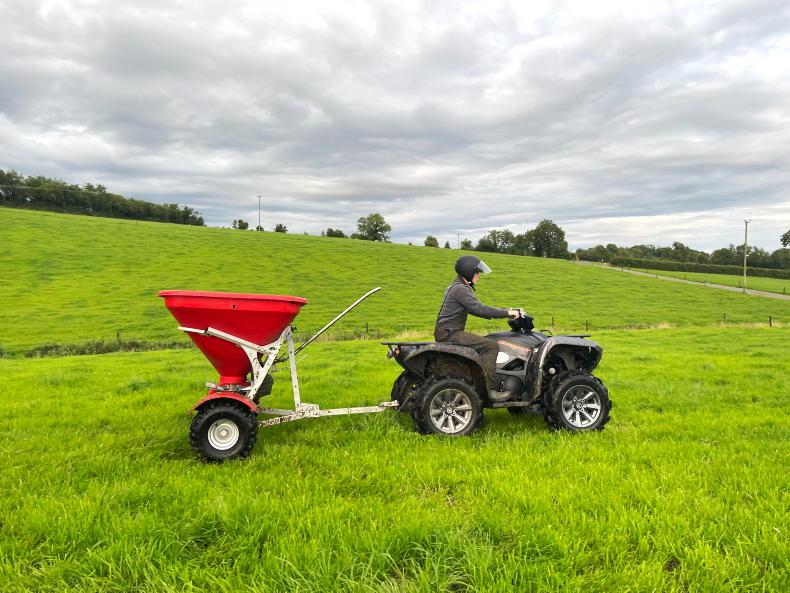
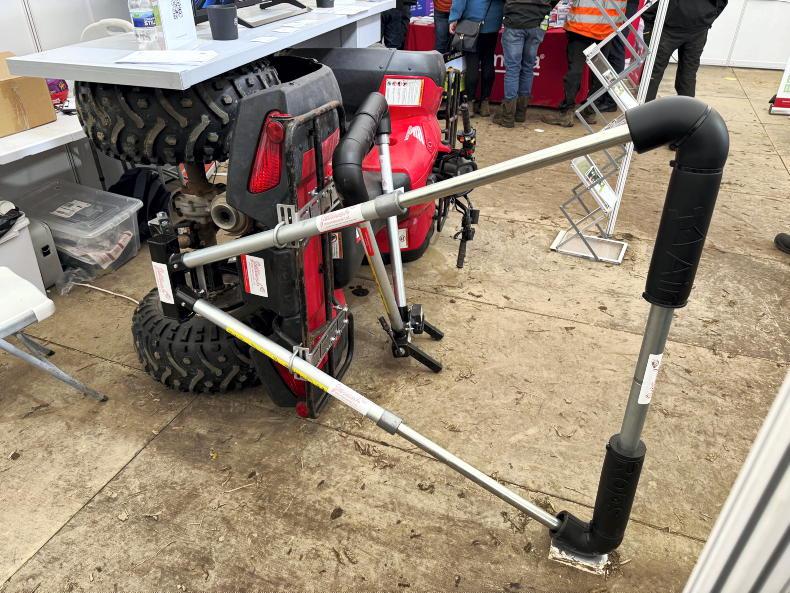
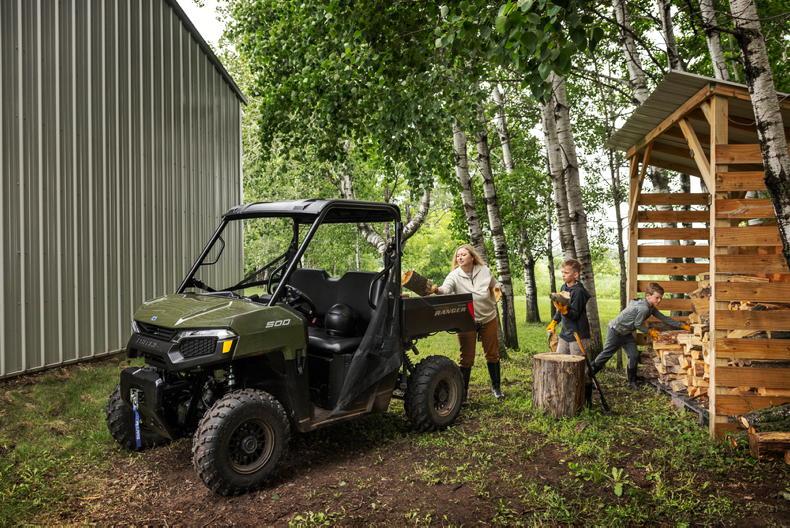
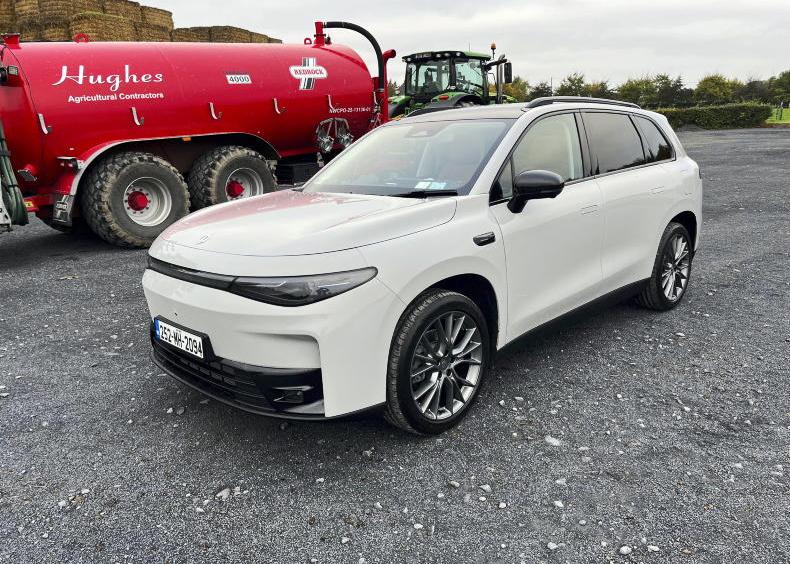
SHARING OPTIONS